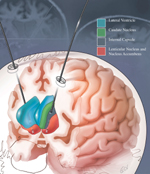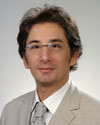|
|

|
Deep Brain Stimulation
Frontier expands in neuroscience, psychiatry
|
by Dawn Brazell
Public Relations
 When
Istvan Takacs, M.D., tells a patient that he will be inserting a probe
about the size of a pencil lead four inches into their brain, for some
reason they think he’s joking. When
Istvan Takacs, M.D., tells a patient that he will be inserting a probe
about the size of a pencil lead four inches into their brain, for some
reason they think he’s joking.
“The patient will look at you and say, ‘That can’t be very good for you.’”
Takacs, a neurosurgeon and director of functional and stereotactic
surgery at MUSC, said the reaction is typical and understandable, but
that Deep Brain Stimulation (DBS) surgery is no more dangerous
than a patient having a gall bladder removed. The therapy, which is
being tried on patients with certain psychiatric disorders, opens up
new options where traditional treatments have failed.
 Dr. Ziad Nahas Dr. Ziad Nahas
In January MUSC became the first center nationally to provide DBS
therapy to treat severe, chronic obsessive-compulsive disorder (OCD) in
a patient. This team effort was lead by Takacs and Ziad H. Nahas, M.D.,
of Psychiatry and Behavioral Medicine.
The surgery, which took three and a half hours, went well. Nahas said
it has been two months since the patient’s stimulator was activated. He
and his family have noticed positive signs with increased socialization
and reduced anxiety. Nahas said it takes time for OCD symptoms to show
improvement with doctors able to assess the therapy’s effectiveness in
another four to eight months. He’s glad to see that the patient appears
to be on the right track.
 “By doing very little or no harm, you can harvest a very large gain.” “By doing very little or no harm, you can harvest a very large gain.”
--Dr. Istvan Takacs
Aside from clinically using DBS to treat obsessive-compulsive
disorders, there are two large multi-center clinical trials
investigating the efficacy of DBS for treatment-resistant major
depression. MUSC is a site and expected to enroll patients late spring,
early summer. Takacs said it will be exciting to see how patients with
psychiatric disorders will respond to new therapies developing in
neuroscience.
The beauty of DBS therapy is that it generates an electric field that
can be switched on or off and that can be modulated in its intensity.
“DBS takes us into a whole new realm when it comes to psychiatric
diseases. Now we have the means to intervene in a reversible fashion,”
he said, mentioning the darker days of psychiatric treatment when
irreversible lobotomies were used, often in questionable ways.
“You remain you. You have not been absolved of the freedom of choice
that is your right. Ethically, it’s an enormous difference.”
Breaking new ground
The Food and Drug Administration (FDA) approved DBS as a treatment for
essential tremor in 1997 and for Parkinson’s disease in 2002.
Parkinson’s patients have an 80 to 90 percent chance of getting at
least 50 percent better, said Takacs. “It’s amazing in the operating
room. If their arm is flapping around, you turn it on and it stops. You
turn it off, and it starts. It’s clear that it’s the dynamic electric
field that is controlling the behavior. It keeps the misbehaving
circuitry in check.”
The treatment has been a new frontier since the 1950s, but it’s been in
the past 30 years that medical science has had the electronics to make
it an acceptable frontier. There are about 60,000 people with DBS
stimulators, who are doing fine, said Takacs. It’s a matter of taking
baby steps to reach the next level of therapy.
Takacs predicts the future of DBS will be to treat psychiatric
disorders rather than movement disorders. “Once there’s one good drug
for Parkinson’s, there will be no need for DBS. For psychiatric
illnesses, however, a drug may affect the whole brain when there’s just
one region that needs to be targeted. They don’t know where to go, so
they go everywhere.”
Technology has developed to a safe level at a time when researchers
know more about regulation centers in the brain, Takacs said. This
allows surgeons to selectively target specific domains, rather than
using a medication that immerses the brain in a chemical that helps
patient's symptoms, but also may cause unwanted side effects.
Nahas said DBS therapy isn’t the only exciting brain stimulation option
for the treatment of psychiatric disorders. MUSC also has pioneered the
use of epidural prefrontal cortical stimulation for treatment-resistant
depression. Epidural stimulation is potentially safer than DBS, but
much more work is needed before its efficacy is established, said Nahas.
He’s also excited about the introduction in the last five years of two
other sub-convulsive brain stimulation therapies for
treatment-resistant depression—vagus nerve stimulation and transcranial
magnetic stimulation.
“MUSC has played a critical role in getting both of these technologies
available to patients,” said Nahas. “We have a very comprehensive
clinical program for brain stimulation therapies in psychiatric
disorders.”
It’s that reputation that enabled MUSC to be the first to offer DBS
therapy clinically to help a patient with OCD. Nahas credits it to
MUSC’s expertise in brain stimulation research, its excellent research
and clinical care and the staff’s comprehensive assessment of the
patient’s history and clinical needs that allowed the patient to be
approved by his insurance carrier.
Takacs agreed and stressed that brain surgery for psychiatric disorders
will never be a mass endeavor, but it will be an essential tool to use
for difficult cases that aren’t responding to more traditional
therapies.
“It’s not the first line of treatment or even the fifth. It’s for
patients who are severely ill and impervious to other kinds of
treatments.”
When asked how he feels about being the first to do the procedure
clinically, Takacs doesn’t hesitate. “We believe in it,” he said, and
then grins with a confident look a patient has to love on a
neurosurgeon’s face. “And we are nimble and quick on our feet.”
The procedure
The surgical treatment involves placing a lead with electrodes along
the anterior limb of the internal capsule in each hemisphere, ending in
the nucleus accumbens, said Takacs. It is done with the patient awake,
and with the surgeon aiming for targets the size of apple seeds.
Obviously, precision is crucial so the patient is placed into a head
frame and has MRI scans to determine reference points. The patient can
move everything except the head.
“On each MRI slice, the reference points from the frame will show up.
... Then it becomes more an exercise of aiming according to
mathematical coordinates.”
A hole is made in the scalp and a hollow tube or cannula is passed
through to the target. The brain has the gelatinous consistency of
jello with blood vessels like spaghetti so that the blunt probe
generally rolls off the vessels, said Takacs. The cannula stops 20 to
25 mm short of the target. Inside that cannula, he passes down a very
thin microelectrode recording probe, which is attached to a machine
that shows wave forms using an oscilloscope with an amplifier.
“It turns out that different centers in the brain have a different
whale song. Certain nuclei in the brain sound like outboard motors.
Some sound like sizzling bacon. Some of them sound like the clicking
sounds of dolphins. As you’re passing down your microelectrode
recording probe, you verify you’re going where you planned to go on
your MRI scans. It’s a double safety thing.”
The system provides a visual and physiological way to confirm that the
probe is where they want it to be. With the site verified, the
permanent electrode is put in place to the same spot where they got the
good reading, said Takacs. Then it is connected with a hand-held
stimulator to be tested. The patient can let them know about side
effects or funny sensations. If it’s a psychiatric disorder, then the
patient may go through various psychological test batteries.
Doctors verify there are no side effects and gently take away the guide
cannula through which the electrode has been placed. The wire is
secured and, in another procedure, an incision is made so the pulse
generation can be placed near the collar bone. The patient is able to
turn it off, but would consult with his doctor for the settings to be
changed.
Takacs said it takes a team effort to push forward in this field, which
requires an interdisciplinary approach between psychiatry and
neuroscience. “Life is a team sport. There is very little you can do on
your own because it has gotten so complex.”
The future
Takacs sees DBS therapy being used to treat various psychiatric
conditions, including treatment-resistant depression, severe OCD and
possibly later for certain eating disorders. It’s an exciting time to
be in neuroscience, a field which used to have the reputation of being
the “dismal science” in that many cases dealt with malignant brain
tumors and head trauma, said Takacs.
“Every once in awhile a technique comes along where you can address
things that you can fix. You have these windows of opportunity. In
neurosurgery, neuromodulation is one of those windows. By doing
very little or no harm, you can harvest a very large gain. It is often
not the case in this specialty that you can score victories and not
have a lot of costs along the way as far as side effects and permanent
deficits with the patient.”
Nahas said MUSC will remain a leader in this field.
“We are committed to getting new treatment that can tangibly bring
improved quality of life to patients in need. There are several other
promising technologies on the horizon. Patients with severe
neuropsychiatric illnesses should remain hopeful.”
Friday, April 23, 2010
|
|
|



 When
Istvan Takacs, M.D., tells a patient that he will be inserting a probe
about the size of a pencil lead four inches into their brain, for some
reason they think he’s joking.
When
Istvan Takacs, M.D., tells a patient that he will be inserting a probe
about the size of a pencil lead four inches into their brain, for some
reason they think he’s joking.
